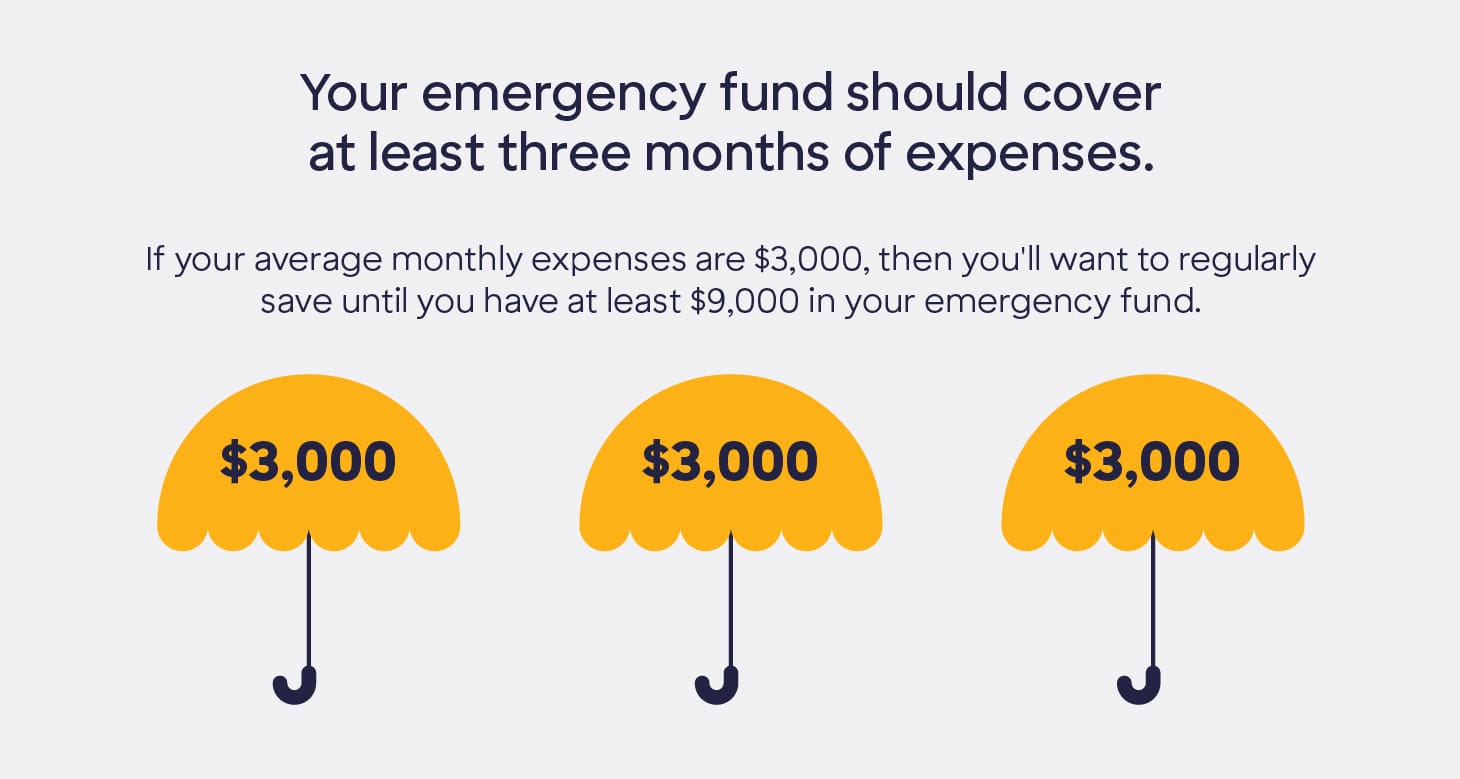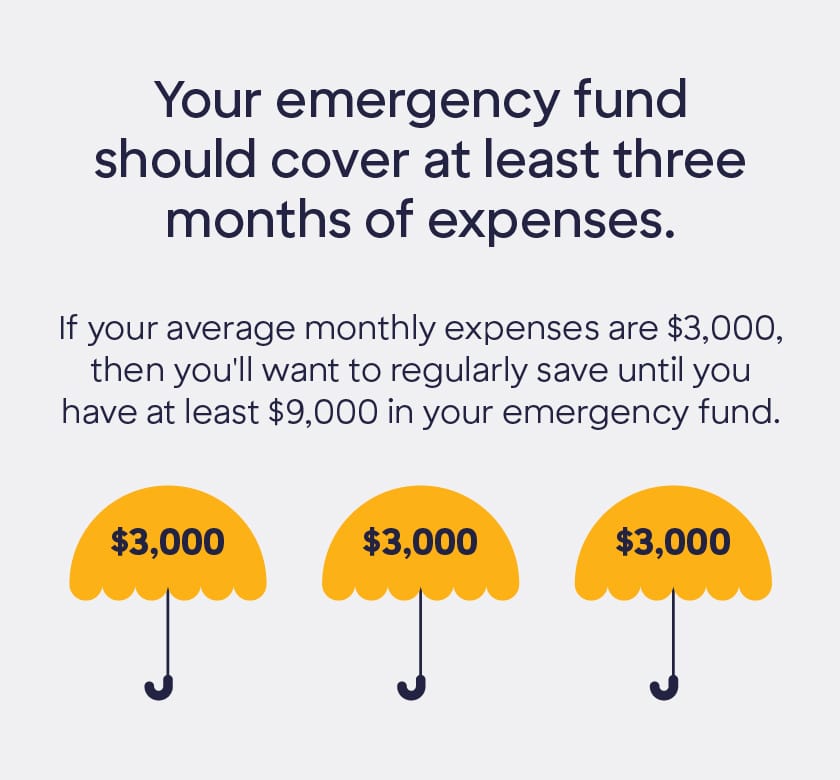How to build an emergency fund: 4 steps to get started
Are you building an emergency fund from scratch? Here’s how to get started in four steps.
It’s a fact of life: Unexpected emergencies happen. It could be a blown transmission in your car or, even worse, the loss of a job. When these situations occur, it’s undoubtedly a stressful time, but being prepared with an emergency fund can make all the difference.
It’s not uncommon to be concerned about the amount of money you have in your emergency savings. If you’re in that situation, you may be wondering: What is an emergency fund, and why is it important?
In short: It’s a rainy day fund that offers the security of knowing you can cover unexpected expenses should the need arise.

Keep in mind that starting your rainy day fund may take time, but there’s no need for the process to feel stressful or overwhelming. It’s all about having a plan, and these four steps to start an emergency fund can help guide you:
1. Treat your emergency fund like a monthly bill
As you think about how to start an emergency fund, begin with your budget. If you don’t have a budget right now, no worries! Start one today with these five budgeting basics.
In your budget, add a line for your emergency fund. If you don’t have excess income, try to find ways to reduce other expenses, so you can start this habit of building up your emergency savings. Once you’ve identified where you can find the money in your budget, set aside a fixed amount of your regular paycheck into a special emergency fund account. When you consider where to keep your emergency fund, you have several good options, including high-yield savings, money market, CD, or IRA accounts.
2. Take baby steps


“Every financial expert sets some number as a benchmark for emergency funds—anywhere from three to six to 12 months of expenses,” says Kerri Moriarty, an accounting and tax professional for a CPA firm based in Wellesley, Massachusetts. “For most people that’s just downright aspirational,” especially, she adds, when paying student loans, a credit card balance, and rent or a mortgage.
Okay, so building an emergency fund with three months or more worth of expenses can feel daunting. That’s why it’s so important to begin with small goals and gradually work up to your long-term objective.
“Reduce your frustration and risk of de-motivation by setting milestone goals to work toward,” Moriarty says. “For example, building up $500 in emergency funds, then $1,000, then $2,500 and so on until you watch yourself tracking to one month or three months or six months covered.”
3. Automate your contributions
Similar to a retirement fund, it’s important to pay into your emergency fund before you have a chance to spend that money. When you start building an emergency fund, set aside a certain percentage of your take-home pay each month and put it straight into your account.
You can set up either a recurring deposit on payday to automate your savings, or a separate direct deposit with your employer as part of the steps to start an emergency fund. Learn more about the best places to keep your emergency fund to ensure it’s safe and accessible—but not too accessible. You don’t want to be tempted to tap into it in non-emergency situations like those new golf clubs!
But don’t stop there. Now that you know how to start an emergency fund, find other creative ways to build your account even faster.
“When you start an emergency fund it can be challenging, but every few dollars helps,” says Brooke Petersen, CFP® and wealth consultant at an investment advisory firm in Harrisburg, Pennsylvania.
“Fund it with pay from extra working hours, a tax refund, or part of a raise,” Petersen says. Getting a raise at work can offer a smart way to boost your savings, but it’s not the only route. Think about smaller changes, too. “Alternatively, bring your lunch to work a few days a week, or brew your morning cup of coffee at home.”

4. Continue building an emergency fund as needed
Once you’ve taken these steps to build up your savings, you may be thinking: I have an emergency fund. Now what? Remember that just because you have a well-funded savings account for emergencies, you shouldn’t stop there. Keep the momentum going by saving for college, retirement, or other goals.
Also keep in mind that your circumstances could change if you get married or have children, for example, and your monthly expenses might increase as a result. When that happens, you need to account for it. The six months’ worth of expenses you originally saved may no longer cover you.
Additionally, if you need to tap into this account at any point, then you’ll have to begin the process of building an emergency fund all over again to replenish the amount you took out.
As you’re learning how to build an emergency fund, you may want to level set on when to use your emergency fund. Think of your emergency fund as money that’s set aside in a separate account to be used for emergencies only. Managing this account requires discipline, as it needs to be used for true emergencies. In other words, a new set of golf clubs doesn’t fit the bill.

Remember: Starting an emergency fund is key
When you start an emergency fund, think of it as a type of insurance policy for you and your family. You have health insurance in case you get sick, car insurance so that you’re covered in an accident, and an emergency fund if something unplanned or unexpected happens.
“The primary investment objective for your emergency reserves is safety, not return,” Petersen says.
By learning how to build an emergency fund now, you can help avoid serious financial problems later. Take the process one step at a time, and you’ll have peace of mind before you know it.
Next, explore four places to store these savings. Learn where to keep your emergency fund.
Articles may contain information from third parties. The inclusion of such information does not imply an affiliation with the bank or bank sponsorship, endorsement, or verification regarding the third party or information.
The information provided herein is for informational purposes only and is not intended to be construed as professional advice. Nothing contained in this article shall give rise to, or be construed to give rise to, any obligation or liability whatsoever on the part of Discover Bank or its affiliates.



